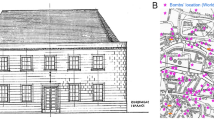Abstract
Rocks’ weathering has been reported world-wide on all sub-aerial materials at a wide range of environmental conditions. It occurs at rates dependent on the durability of rocks, the number, and the intensity of weathering cycles. A wide spectrum of weathering forms and damage categories can result from weathering processes. This paper focuses on the specification and correlation of damage categories on an ancient sandstone wall of Aachen City, Germany. For this purpose, site investigations are conducted using a non-destructive technique for a period from August 2007 to August 2014. The comparison of weathering forms and their dimensions for a period of 7 years enables us determining the weathering progress expressed by an increase in the dimensions of weathering forms and/or creation of new weathering forms on this building material. Thereby, it can be decided whether any restoration is necessary for some parts or all parts of the wall or not. Assuming that the environmental conditions do not change significantly, this study also shows which weathering form or weathering group resulted in higher ranks of damage category at the present time and in the future.











Similar content being viewed by others
References
Angeli M, Bigas JP, Benavente D, Menendez B, Hebrt R, David C (2007) Salt crystallization in pores: Quantification and estimation of damage. Environ Geol 52(2):205–213
Antonia M, Bakolas A, Petros M (2000) Criteria and methodology for restoration mortars compatible to the historic materials and structures. 9th Int. Congress on Deterioration and Conservation of Stone, Venice 19–24 June 2000, 403–411
Benavente D, Cura G, Fort MA, Ordonez S (2004) Role of pore structure in salt crystallization in un saturated porous stone. J Cryst Growth 260:532–544
Fitzner B (2004) Assessment of weathering damage on stone monuments. In: Akasheh TS (ed) Proceedings of the First Int. Conference on Science and Technology in archaeology and Conservation, 12–17 August, 2002, Jordan, Actas, Granada, Spain, 171–207
Fitzner B, Heinrichs K (2002) Damage diagnosis on stone monuments—Weathering forms, damage categories and damage indices. In: Prikryl R, Viles HA (eds) Understanding and managing stone decay. the Karolinum Press, Prague, pp 11–56
Fitzner B, Heinrichs K, Kownatzki R (1995) Denkmalpflege und Naturwissenschaft, Naturstein-konservierung, V. 1 Berlin Ernst and Sohn, 41–88
Flatt RJ (2002) Salt damage in porous materials: how high supersaturations are generated. J Cryst Growth 242:435–454
Heinrichs K, Fitzner B (2007) Stone monuments of the Nemrud Dag sanctuary/Turkey—Petrographical investigation and diagnosis of weathering damage. Z Dtsch Ges Geowiss 158(3):519–548
Kamh GME (2004) Rate and origin of cavernous “honeycomb” weathering of Qaytbei Fort, Alexandria, Egypt. Sedimentol Egypt 12:105–118
Kamh GME (2005) Weathering at high latitudes on the Carboniferous Old Red Sandstone, petrographic and geotechnical investigations, Jedburgh Abbey Church, Scotland, a case study. Environ Geol 47(4):482–492
Kamh GME (2010) Quantification of the damage category of sandstone at Ramesseum Temple, a case study. Restor Build Monum Int J 16(6):477–494
Kamh GME (2011) Salt weathering, bio-deterioration and rate of weathering of dimensional sandstone in ancient buildings of Aachen City, Germany. Int J Water Resour Environ Eng 3(5):87–92
Moropoulou A, Bakolas A (1998) Range of acceptability limits of physical, chemical and mechanical characteristics deriving from the evaluation of historic mortars. PACT 56:165–178
Moropoulou A, Bakolas A, Moundoulas P, Cakmak AS (1999) Compatible restoration mortars for Hagia Sophia earthquake protection, Advances in Earthquake Engineering, 4, edn. In: Oliveto G, Brebbia CA (eds) Publ. Wessex Institute of Technology, 521–531
Paradise TR (2000) Sandstone architectural deterioration in Petra, Jordan. Proceedings of the 9th Int. Congress on the Deterioration and Conservation of Stone, 19–24 June 2000, Venice, Italy, V. 1 Elsevier, Amsterdam, 145–154
Price CA (1996) Methods of evaluating products for the conservation of porous building material in monuments. Sci Technol Cult Herit 5(1):105–109
Swe Y, Oguchi CT (2010) Role of pore size distribution in salt uptake, damage and predicting salt susceptibility of eight types of Japanese building stones. Eng Geol 115:226–236
Acknowledgments
The authors are greatly thankful for the financial support of the Deutscher Akademischer Austausch Dienst (DAAD) to conduct this research that is part of the full project plan conducted under WAP (Bilateral Exchange) program of the DAAD at Aachen Univ., Germany
Author information
Authors and Affiliations
Corresponding author
Rights and permissions
About this article
Cite this article
Kamh, G.M.E., Koltuk, S. Specification and correlation of damage category over 7 years on sandstone wall of Aachen City, Germany, case study. Arab J Geosci 8, 9325–9343 (2015). https://doi.org/10.1007/s12517-015-1901-9
Received:
Accepted:
Published:
Issue Date:
DOI: https://doi.org/10.1007/s12517-015-1901-9




